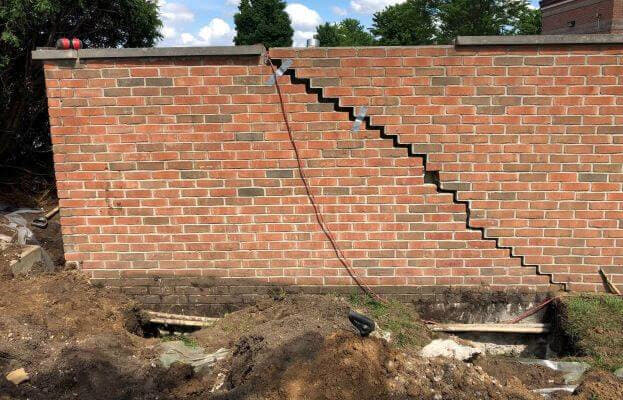
Do you have a retaining wall on your property that is starting to crack and bow? Or a stately column at the end of your driveway that is beginning to lean? You’ve probably wondered who to call, or how these items can be repaired. We have the answers to these questions, and more!
If the structure is made of brick or stone, including the base underneath, you will need to call a quality mason or masonry company.
But if the structure is made of concrete block, poured concrete, or brick/stone with a concrete base? You need a reputable and experienced foundation repair company.
Founded in 1996, Acculevel is a family-owned and operated company. We’ve repaired tens of thousands of foundations throughout our five state service area, and we want you to be confident in both the contractor working on your home and the repair method being used.
In this blog, we’re going to explain which foundation repair methods can be successfully implemented on other structures on your property. We’ll provide resources that help you learn more about each method and its pricing, with before and after photos of projects successfully completed using those methods.
Bowing wall repair methods aren’t only effective on basement or crawl space walls. Carbon fiber straps, anchors, and tiebacks can be used to repair retaining walls also. This blog details each of these repair methods and provides approximate costs.
Here’s a retaining wall that we repaired with anchors. The wall is poured concrete, is cracking in multiple places, and is leaning inward towards the pool.
All of the following photos were taken by Acculevel staff. Project managers took the “before” images during a routine estimate appointment. Crew members took pictures detailing the work as it progressed.
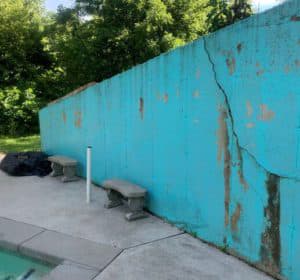 Retaining wall that is cracked and leaning inward
Retaining wall that is cracked and leaning inward
To briefly explain what you’re seeing, let’s summarize how wall anchors work. If a wall is bowing, bulging or leaning more than 2 inches, we recommend wall anchors. You need at least 10 feet of usable ground outside the wall to install the anchor.
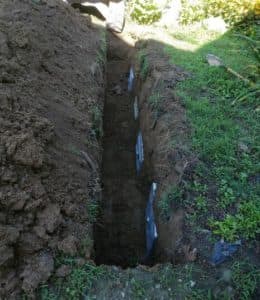 Excavation behind the wall, for the anchor portion of the wall anchor.
Excavation behind the wall, for the anchor portion of the wall anchor.
A steel plate or channel is secured in the yard, approximately 10 feet away from the wall in solid ground. Steel shafts are drilled through the wall and secured to the anchors, which are then buried. Anchors should be installed approximately every 5 feet.
 Steel rods are driven through the wall to connect the wall to the anchors.
Steel rods are driven through the wall to connect the wall to the anchors.
A steel plate is attached to the rods, then secured to the wall. Once this is accomplished, the steel rods are tightened. With the anchor held securely in the ground, the wall is slowly pulled tight, then held fast.
This may not fully straighten the wall to its original position, but it stabilizes the structure so that it cannot move any farther. (Acculevel warranties their wall anchor installations for the life of the structure.) If your goal is to have the wall fully straightened, this may be possible. But straightening a retaining wall requires a good deal of excavation- all the way down to the footer poured beneath the wall.
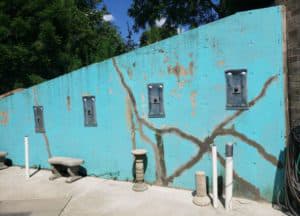 Now that the wall is stabilized, the cracks can be filled with epoxy. (Crack repairs can be painted over, if the homeowner wishes.)
Now that the wall is stabilized, the cracks can be filled with epoxy. (Crack repairs can be painted over, if the homeowner wishes.)
If you have questions about the crack repair method, this blog explains how epoxy fill works, why we prefer this method over others, and what it costs.
At the beginning of this article, I mentioned that brick structures need a mason, unless they have a concrete base. A perfect example of this is a brick privacy wall Acculevel repaired by installing helical piers.
 This brick wall was built on top of a poured concrete base, which had cracked. This break in the base allowed the outside corner to pull away and settle.
This brick wall was built on top of a poured concrete base, which had cracked. This break in the base allowed the outside corner to pull away and settle.
A helical pier is a long steel post with helical (screw-like) blades along the shaft. A pier is screwed through the ground until it hits stable, undisturbed soil. A pressure gauge system is used to determine when the pier has reached the necessary depth (soil level where it is stable enough to support the structure).
At the top of the pier is a steel bracket that is fitted under the foundation’s footing, to give the wall support and hold it in place. This bracket allows the pier to leverage the resistance between the deep solid ground at the bottom of the pier and the structure it’s reinforcing.
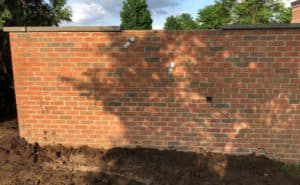 Once the piers were installed and the wall stable, the crew successfully used the piers to lift the wall back into position.
Once the piers were installed and the wall stable, the crew successfully used the piers to lift the wall back into position.
The purpose of helical piers is stabilization. They can’t always lift the foundation of a home- there are a lot of variables to consider before you try to shift an entire house! But it’s usually an easier task to lift or straighten a structure that does not have a building on top of it. In this second picture, you can see the corner was lifted enough to close the gaps created by the crack. The property manager will hire a mason to re-mortar the crack and replace the missing brick.
Helical Piers can fix almost any settling structure, as long as it has a concrete base. This includes chimneys, deck posts, statues, decorative columns, monuments, or signs like the one below.
 We will install piers at the base of this sign to stabilize and straighten it.
We will install piers at the base of this sign to stabilize and straighten it.
This blog further explores the installation process for helical piers and provides details about costs.
Do you have a retaining wall or other concrete structure that needs repair? If you live in Indiana or the surrounding areas, call Acculevel! One of our friendly customer care representatives will schedule a free appointment for you. Our knowledgeable project managers will evaluate your home and provide a written estimate, valid for 12 months.
If you don’t live in our service area, please make sure you verify that your contractor is insured and accredited by the Better Business Bureau.
Not familiar with the process of finding or meeting with a contractor? We offer a free downloadable guide of questions to ask a contractor. This can help you interview and vet companies,to find the best fit for you and your home.
[DISPLAY_ULTIMATE_SOCIAL_ICONS]